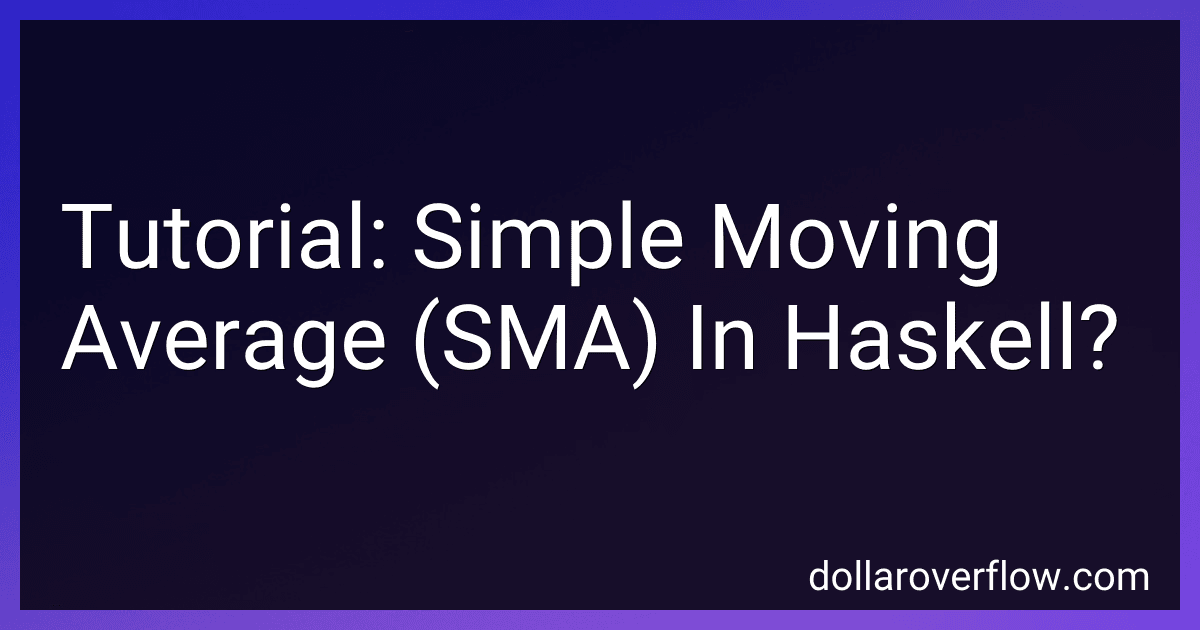A simple moving average (SMA) is a statistical calculation used to analyze data points by creating a series of averages of different subsets of the full data set. In Haskell, we can implement a simple moving average function using recursion and list manipulation.
To calculate the SMA, we first need to define a function that takes a list of numbers and an integer representing the window size as parameters. The window size determines how many data points will be used to calculate each average.
We can then define a recursive function that takes the list of numbers, window size, and an empty list as parameters. This function will loop through the list of numbers, taking subsets of the data based on the window size, calculating the average of each subset, and appending it to the empty list.
Finally, we can call this recursive function with the list of numbers and window size to get the series of averages. This simple moving average function in Haskell can be a useful tool for analyzing time-series data and identifying trends or patterns within the data set.
How to calculate SMA with different time periods in Haskell?
To calculate the Simple Moving Average (SMA) with different time periods in Haskell, you can define a function that takes a list of values and a time period as input and returns the SMA value.
Here is a sample implementation:
sma :: [Double] -> Int -> [Double] sma xs period = map (\i -> sum (take period (drop i xs)) / fromIntegral period) [0..(length xs - period)]
In this implementation, the sma function takes a list of values xs and a time period period as input. It then generates a list of SMA values by calculating the sum of the values in a window of size period and dividing it by the period. The function returns a list of SMA values for each window in the input list.
You can call this function with different time periods to calculate SMA values for different time periods. For example:
main :: IO () main = do let prices = [10.0, 12.0, 14.0, 16.0, 18.0, 20.0, 22.0, 24.0, 26.0, 28.0] let smaValues5 = sma prices 5 let smaValues10 = sma prices 10
print smaValues5
print smaValues10
In this example, we have a list of prices and we calculate the SMA values for time periods of 5 and 10. The smaValues5 and smaValues10 lists will contain the SMA values for the corresponding time periods.
You can customize the implementation further based on your requirements, such as handling edge cases, rounding the SMA values, or using a more efficient algorithm for calculating the SMA.
What is the importance of using SMA in algorithmic trading?
The Simple Moving Average (SMA) is one of the most commonly used technical indicators in algorithmic trading. It is calculated by taking the average price of a security over a specific time period.
There are several reasons why using SMA in algorithmic trading is important:
- Trend identification: SMA helps in identifying the direction of the trend of a security. Traders can use SMA to determine whether a security is in an uptrend, downtrend, or sideways trend. This information can help traders make better trading decisions.
- Support and resistance levels: SMA can act as support or resistance levels for a security. When the price of a security crosses above the SMA, it can act as a support level, and when the price crosses below the SMA, it can act as a resistance level.
- Entry and exit signals: SMA can be used to generate buy and sell signals. For example, a trader may enter a long position when the price crosses above the SMA and exits the position when the price crosses below the SMA.
- Risk management: SMA can help in managing risk by providing traders with information on when to enter and exit trades. By using SMA, traders can set stop-loss orders at SMA levels to limit potential losses.
Overall, SMA is an important tool in algorithmic trading as it can help traders identify trends, support and resistance levels, generate entry and exit signals, and manage risk effectively.
How to handle missing data when calculating SMA?
There are several ways to handle missing data when calculating the Simple Moving Average (SMA). Some common approaches include:
- Ignore the missing data: One option is to simply ignore the missing data points and calculate the SMA based on the available data. This is the simplest approach, but it can potentially skew the results if there are a large number of missing data points.
- Interpolate the missing data: Another approach is to use interpolation techniques to estimate the missing data points. This could involve linear interpolation, spline interpolation, or some other method to fill in the gaps in the data.
- Use a rolling window: Instead of calculating the SMA based on all available data points, you could use a rolling window approach where you only include the most recent n data points in the calculation. This can help mitigate the impact of missing data on the SMA calculation.
- Use a different moving average: If missing data is a persistent issue, you could consider using a different type of moving average that is more robust to missing data, such as the Exponential Moving Average (EMA) or Weighted Moving Average (WMA).
Ultimately, the best approach will depend on the specific characteristics of your data and the goals of your analysis. It's important to carefully consider the implications of each approach and choose the method that best suits your needs.
